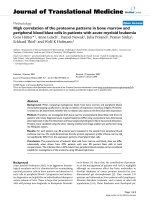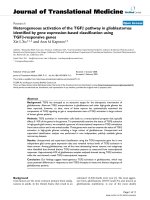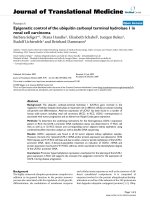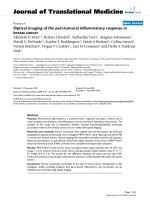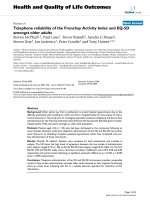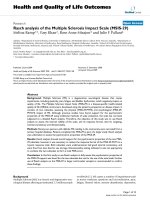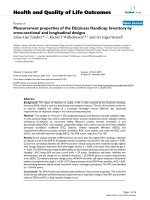báo cáo hóa học:" Superior dislocation of the patella: a case report" pptx
Bạn đang xem bản rút gọn của tài liệu. Xem và tải ngay bản đầy đủ của tài liệu tại đây (380.8 KB, 3 trang )
BioMed Central
Page 1 of 3
(page number not for citation purposes)
Journal of Orthopaedic Surgery and
Research
Open Access
Case report
Superior dislocation of the patella: a case report
Xavier Cusco, Roberto Seijas*, Oscar Ares, Jose R Cugat, Montserrat Garcia-
Balletbo and Ramon Cugat
Address: Orthopedic and Trauma Surgery, Fundación García Cugat Hospital Quiron Barcelona – Spain
Email: Xavier Cusco - ; Roberto Seijas* - ; Oscar Ares - ;
Jose R Cugat - ; Montserrat Garcia-Balletbo - ; Ramon Cugat -
* Corresponding author
Abstract
Background: Superior dislocation of the patella is an uncommon condition that mainly occurs in
knees with a high patella and medial femorotibial degenerative arthritis. There are no previous
reports of this condition occurring in association with tibial valgus osteotomy. Case report: We
report the case of a patient in whom vertical dislocation recurred twice at 4 months after tibial
valgus osteotomy. To avert additional recurrence or new dislocations, the patient was treated
surgically to remove the existing osteophytes. Conclusions: An arthroscopic approach was decided
because of the lower associated morbidity and good results with this technique compared to open
surgery.
Introduction
Superior dislocation of the patella is rare; fewer than 20
cases have been reported in the English literature [1,2].
Patients with this condition often have a high patella and
degenerative disease of the femoropatellar joint with oste-
ophytes. There have been no reports of this condition in
patients who have undergone valgus osteotomy of the
tibia.
We report the first case of superior patellar dislocation
related with prior tibial valgus osteotomy, which was
resolved by orthopedic reduction and arthroscopic
removal of the osteophytes that blocked the kneecap at
the time of dislocation.
Case
A 52-year-old woman with medial femorotibial degenera-
tive arthritis of the knee underwent physiotherapy to
strengthen the quadriceps musculature, without success.
Because of persistent mechanical pain, femorotibial and
femoropatellar arthroscopy was performed, with debride-
ment of the medial meniscus, synovectomy, closed tibial
osteotomy, and osthosynthesis with a plate. The patient
progressed favorably, began to walk at 4 weeks, and was
able to carry out daily activity at 6 weeks.
Four months later, she came to the emergency room after
a sudden movement involving hyperextension, which
resulted in pain and an inability to move the operated
knee. Radiographs showed superior dislocation of the
patella (figure 1), which was manipulated to obtain
immediate orthopaedic reduction without the need for
anesthesia. After reduction (figure 2), the patient experi-
enced complete pain relief and restoration of joint mobil-
ity. Seventy-two hours later, she had another dislocation
with self-reduction. Arthroscopic femoropatellar exami-
nation was then decided. The procedure, carried out 8
days later, revealed the presence of femoropatellar osteo-
phytes in the area of the dislocation, which were com-
pletely removed. The patient progressed satisfactorily and
Published: 30 July 2009
Journal of Orthopaedic Surgery and Research 2009, 4:29 doi:10.1186/1749-799X-4-29
Received: 25 April 2009
Accepted: 30 July 2009
This article is available from: />© 2009 Cusco et al; licensee BioMed Central Ltd.
This is an Open Access article distributed under the terms of the Creative Commons Attribution License ( />),
which permits unrestricted use, distribution, and reproduction in any medium, provided the original work is properly cited.
Journal of Orthopaedic Surgery and Research 2009, 4:29 />Page 2 of 3
(page number not for citation purposes)
had no new episodes of dislocation or knee problems over
a follow-up of 2 years.
Discussion
Superior dislocation of the patella has been reported in 18
patients, all except one with degenerative patellofemoral
alterations [1,2]. Watson-Jones described the first case in
1956 [3,4]. The average age of presentation is 58 years
(34–81), and logically, at a younger age it is less likely that
patellar osteophytes are involved [5,6]. The single patient
without degenerative disease was a 34-year-old man in
whom the cause of superior patellar dislocation was a
direct impact with hyperextension [2]. Our patient was 52
years old at presentation, which is consistent with the
usual age range.
A high patella has been proposed as a predisposing factor
[3,5,7] for this type of dislocation, as it is associated with
several of the reported cases. The combination of a high
patella and patellofemoral arthrosis constitutes a true risk
factor because it favors the creation of free bodies [3,7]
and osteophytes [5,8] at the inferior pole of the patella
and the superior trochlea [9].
None of the reported cases have been related with previ-
ous tibial corrector osteotomy, as occurred in our patient,
who underwent a valgus osteotomy of the tibia to treat
degenerative disease of the medial femorotibial compo-
nent. Occlusive osteotomy results in an increase in the
patellar height.
The mechanism causing superior dislocation seems to be
forced contraction of the quadriceps, with or without
hyperextension of the knee [4,5,8,10]. Patellar disloca-
tions are classified as intra-articular, which consists of
rotation on the axial or vertical axis, or extra-articular,
which can involve associated tendon rupture in addition
to rotation [9]. In the reported cases of recurrent disloca-
tion, the following risk factors have been described: high
patella, ligament laxity, neurological alterations (paraly-
sis), and previous severe genu recurvatum [4].
The differential diagnosis must be established with rup-
ture of the patellar tendon [8,11]. In our patient there was
Lateral radiograph showing the kneecap in superior disloca-tion with blocking in the osteophytosis of the inferior patellar pole and femoral osteophyteFigure 1
Lateral radiograph showing the kneecap in superior
dislocation with blocking in the osteophytosis of the
inferior patellar pole and femoral osteophyte.
Following orthopedic reduction, the presence of anterior femoral osteophytes is more evidentFigure 2
Following orthopedic reduction, the presence of
anterior femoral osteophytes is more evident.
Publish with BioMed Central and every
scientist can read your work free of charge
"BioMed Central will be the most significant development for
disseminating the results of biomedical research in our lifetime."
Sir Paul Nurse, Cancer Research UK
Your research papers will be:
available free of charge to the entire biomedical community
peer reviewed and published immediately upon acceptance
cited in PubMed and archived on PubMed Central
yours — you keep the copyright
Submit your manuscript here:
/>BioMedcentral
Journal of Orthopaedic Surgery and Research 2009, 4:29 />Page 3 of 3
(page number not for citation purposes)
an absence of patellar gap, palpable conservation of the
patellar tendon [9], anterior leaning of the kneecap, and
absence of a high patella, ruling out a ruptured tendon.
Another entity that should be taken into account is verti-
cal intra-articular dislocation.
Conventional radiography is the most common imaging
study used in these patients. However, MR imaging is
highly useful to visualize osteocartilaginous injuries [8]
and is a helpful diagnostic test to rule out patellar liga-
ment rupture [8].
Treatment for superior dislocation of the patella usually
consists in local anesthesia and manipulation of the knee-
cap to unblock the osteophytes [1,2,8]. In recurrent cases,
surgery has been proposed [6], involving arthroscopic
debridement with removal of the osteophytes and chon-
dral smoothing [3,5,8,10]. Some authors defend conserv-
ative management, even in recurrent cases [4]. Our patient
had evident signs of degeneration at the site where the
patella had blocked and two episodes of dislocation
within 72 hours. We proposed arthroscopic surgery as a
safe technique with less morbidity compared to open sur-
gery to avert the risk of further dislocations. The osteo-
phytes, which were in contact between the troclea and
patella, were eliminated with an arthroscopic procedure.
Consent section
Written informed consent was obtained from the patient
for publication of this case report and accompanying
images. A copy of the written consent is available for
review by the Editor-in-Chief of this journal.
Competing interests
The authors declare that they have no competing interests.
Authors' contributions
Dr. X.C. and Dr. R.C. were the surgeons of the patient. Dr.
JR.C and Dra. M.G-B were the revisors of the references.
Dr. O.A and Dr. R.S conceived the paper and the writters
of the paper. All the authors read and approved the final
manuscript.
References
1. Bassi RS, Kumar BA: Superior dislocation of the patella; a case
report and review of the literatura. Emerg Med J 2003, 20:97-98.
2. Saleemi AJ, Hussain A, Iqbal MJ, Thuse MG, George AA: Superior
dislocation of patella in a rugby player: an update on a
extremely rare condition and review of literature. Knee Surg
Sports Traumatol Arthrosc 2007, 15(9):1112-3. Epub 2007 Jan 23
3. Hansen B, Beck C, Townsley R: Arthroscopic renoval of a loose
body osteophyte fragment after superior dislocation with
locked osteophytes. Arthroscopy 2003, 19(3):1-4.
4. Yip DK, Wong JW, Sun LK, Wong NM, Chan CW, Lau PY: The
management of superior dislocation of the patella with
interlocking osteophytes – an update on a rare problem. J
Orthop Surg (Hong Kong). 2004, 12(2):253-257.
5. Takai S, Yoshino N, Hirasawa Y: Arthroscopic treatment of vol-
untary superior dislocation of the patella. Arthroscopy 1998,
14(7):753-756.
6. Wood L, Stirrat AN: Superior dislocation of the patella: a case
report and review of the literature. Knee 1998, 5(4):299-300.
7. McWilliams TG, Binns MS: A locked knee in extension: a com-
plication of a degenerate knee with patella alta. J Bone Joint
Surg Br 2000, 82-B:890.
8. Iowerth A, Thomas R, Shewring DJ: Confirmation of an intact
patellar tendon in superior dislocation of the patella using
magnetic resonante imaging. Injury 2001, 32:167-169.
9. Ofluoglu O, Yasmin D, Donthineni R, Yildiz M: Superior disloca-
tion of the patella with early onset patellofemoral arthritis:
a case report and literature review. Knee Surg Sports Traumatol
Arthrosc 2006, 14:350-355.
10. Harris NJ, Hay S, Bickerstaff DR: Recurrent traumatic superior
dislocation of the patella with interlocking osteophytes. The
Knee 1995, 2(3):181-182.
11. Scott SJ, Molloy A, Harvey RA: Superior dislocation of the patella
– a rare but important differential diagnosis of acute knee
pain – a case report and review of the literature. Injury 2000,
31:543-545.
